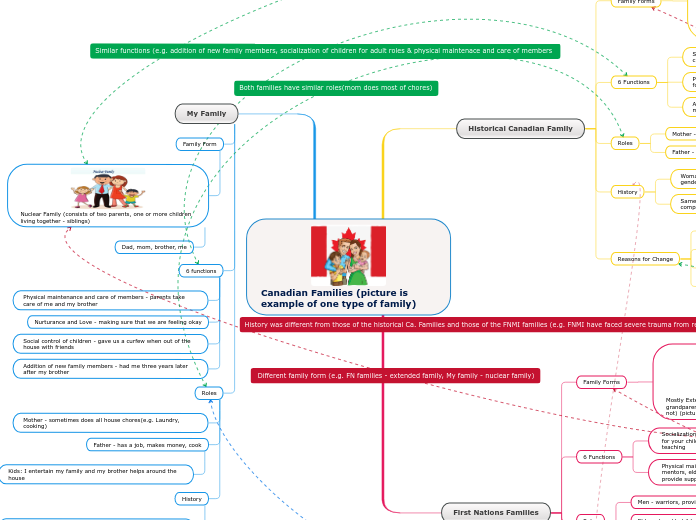
Canadian Families (picture is example of one type of family)
Historical Canadian Family
Family Forms

Nuclear Family(consists of two parents, one or more children living together - siblings) (Picture is not my family)
6 Functions
Socialization of children for adult roles - preparing/sending children to school
Physical maintenance and care of members - making dinner for family
Addition of new family - giving birth to a child/procreation more popular
Roles
Mother - does all house chores (e.g. cooking, cleaning)
Father - gets a job, make money
History
Woman and men (mostly woman) move out of “traditional” gender roles (jobs)
Same-sex couples now have a lot of opportunities as a couple, compared to a heterosexual relationship
Reasons for Change
Divorce
Birth of children
Loss of job/employment
Neglect (neglecting from responsibilities)
First Nations Families
Family Forms

Mostly Extended family(parents, children, aunts, uncles, grandparents, and another blood relations, living together or not) (picture is an example of FNMI families)
6 Functions
Socialization of children for adult roles - e.g. become a teacher for your children/teach young ones to continue the circle of teaching
Physical maintenance and care of members - e.g. guided by mentors, elders, teachers or Elders, parents and grandparents provide support
Roles
Men - warriors, providers and protectors
Elders- taught children
Women - tended to the home fire
History
Residential schools (students that went there that are returning home became stranded, disconnected from their communities
Couldn’t speak their native language
Reasons for change
Separation
Divorce
Violence
Substance abuse to cope with trauma from residential schools
My Family
Family Form

Nuclear Family (consists of two parents, one or more children living together - siblings)
Dad, mom, brother, me
6 functions
Physical maintenance and care of members - parents take care of me and my brother
Nurturance and Love - making sure that we are feeling okay
Social control of children - gave us a curfew when out of the house with friends
Addition of new family members - had me three years later after my brother
Roles
Mother - sometimes does all house chores(e.g. Laundry, cooking)
Father - has a job, makes money, cook
Kids: I entertain my family and my brother helps around the house
History
Parents met in Romania (country in Europe), moved to Canada, had my brother, then me
Reasons for change
Hasn’t been any changes
